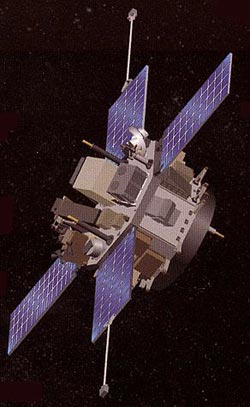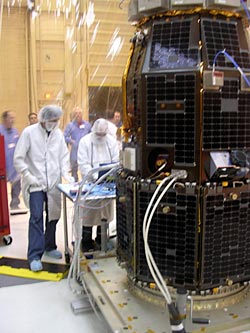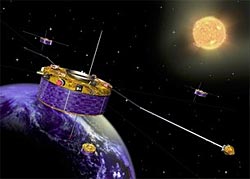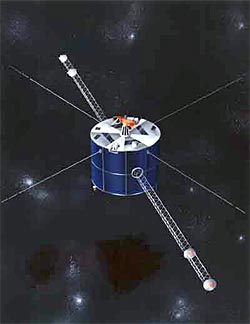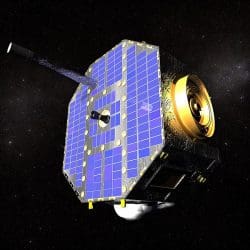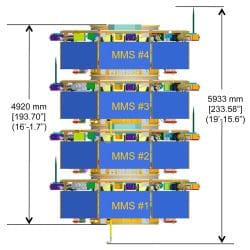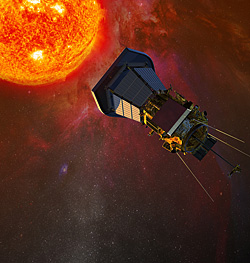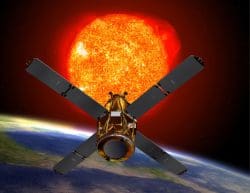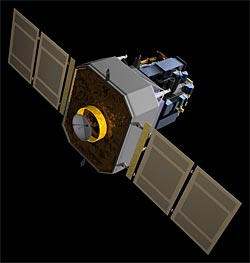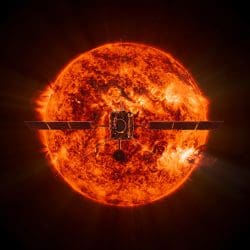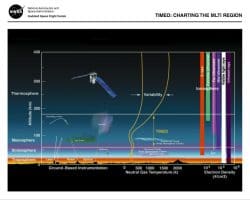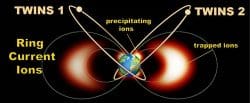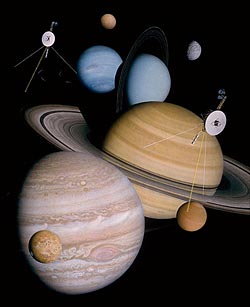ALL SOLAR MISSIONS
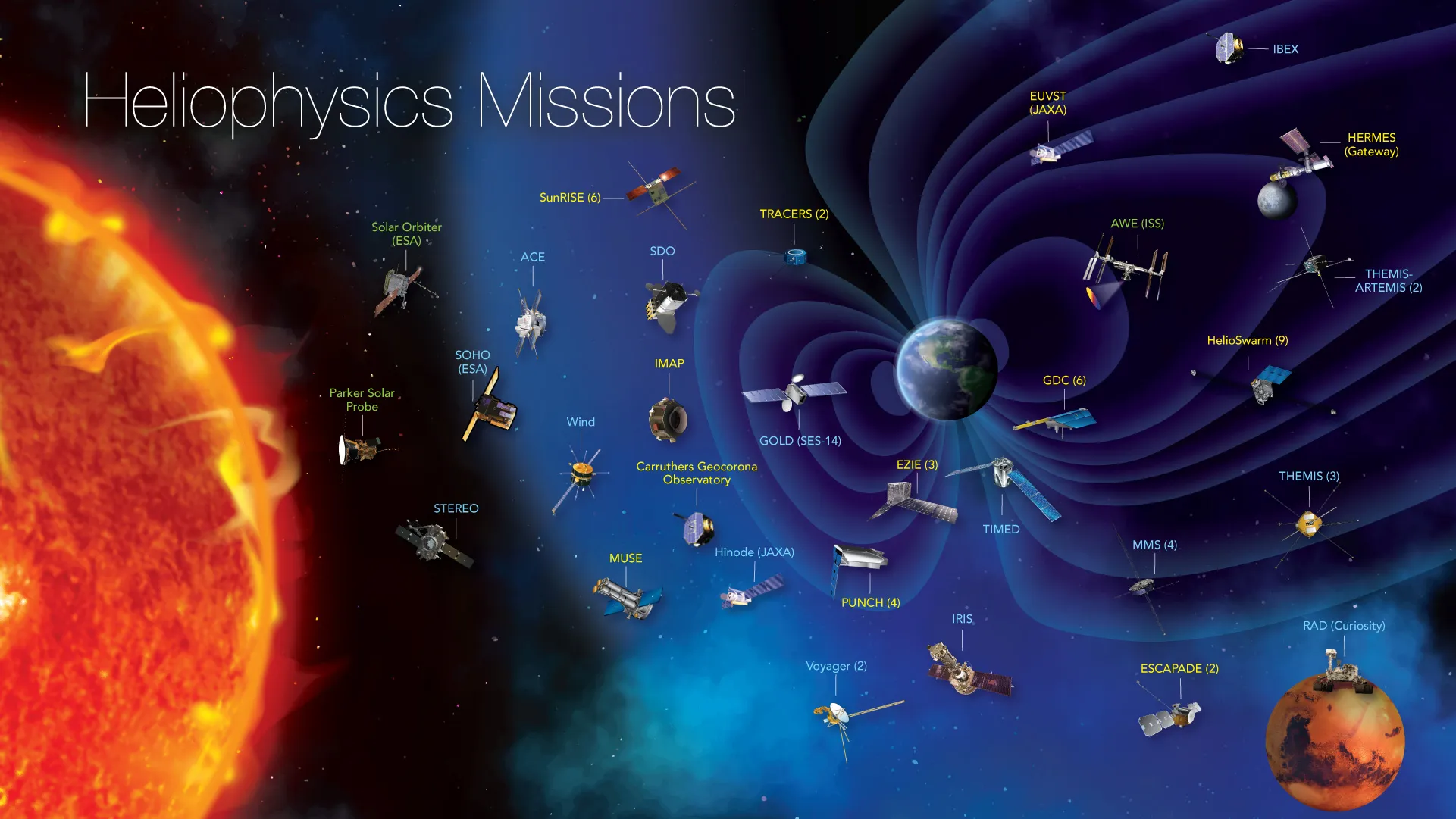
Current Missions
Click the images to see a larger version.
ACE – Advanced Composition Explorer
Launch: August 25, 1997
Mission: ACE observes and measures in unprecedented detail the composition of particles from the solar wind as well as galactic cosmic rays, Its prime objective is to improve measurements of the composition of diverse samples of matter associated with the sun, the interstellar medium, and the galaxy surrounding us. ACE is capable of providing near-real-time solar wind and magnetic field information that aids in forecasting space weather. Advance knowledge of solar wind disturbances heading our way – of about half an hour – can help mitigate the effects of geomagnetic storms that can overload power grids and disrupt communications on Earth.
Orbit: ACE orbits the L1 Lagrangian point, which is a point of gravitational equilibrium between Earth and the sun, about 950,000 miles from Earth and 92 million miles from the sun. This orbit affords ACE a prime location in the solar wind flow that heads toward Earth.
Mission Homepage »
ARTEMIS — Acceleration, Reconnection, Turbulence and Electrodynamics of the Moon’s Interaction with the Sun
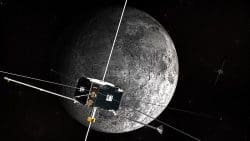
Credit: NASA
Launch: Launched as part of the THEMIS mission on Feb 17, 2007. Began moving into lunar orbit in spring 2010.
Mission: The ARTEMIS mission studies the Moon’s space environment, surface composition and magnetic field, and core structure.
ARTEMIS uses two spacecraft from the completed THEMIS magnetosphere mission that were moved into place near the moon. This allowed NASA to repurpose two in-orbit spacecraft and extend their useful science mission.
Orbit: Both spacecraft orbit the moon. On their journey from their previous orbit around Earth, the spacecraft made flight mechanics history as they were the first to ever achieve orbit around the moon’s Lagrangian points.
Mission Homepage »
CINDI – Coupled Ion-Neutral Dynamics Investigations
Launch Date: April 16, 2008
Mission: The Coupled Ion-Neutral Dynamics Investigations (CINDI) is a project to understand the dynamics of Earth’s ionosphere. CINDI provides two instruments for the Communication/Navigation Outage Forecast System (C/NOFS) satellite, which is a United States Air Force project. C/NOFS helps predict the behavior of equatorial ionospheric irregularities, which can cause major problems for communications and navigation systems.
Orbit: Low Earth orbit
Mission Homepage »
Cluster II
Launch Date: July 16, 2000
Mission: Cluster is a joint ESA/NASA mission that provides in-situ investigation of plasma processes in Earth’s magnetosphere using four identical spacecraft. The four spacecraft make it possible to better observe three-dimensional and time-varying phenomena, as well as to distinguish between the two as it moves through space in its orbit around Earth.
Orbit: Highly elliptical Earth orbit that regularly crosses in and out of the boundaries of the magnetosphere.
Mission Homepage »
Geotail
Launch Date: July 24, 1992
Mission: Geotail is a joint JAXA/NASA mission. Its primary objective is to study the dynamics of the entire length of Earth’s magnetotail, from the near-Earth region to the distant tail.
Orbit: Highly elliptical Earth orbit
Mission Homepage »
Hinode
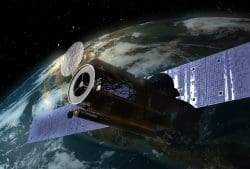
Image credit: NASA/GSFC/C. Meaney
Launch Date: September 22, 2006
Mission: A joint JAXA/NASA/ESA/STFC mission, Hinode explores the magnetic fields of the sun in order to improve understanding of what power the solar atmosphere and drives solar eruptions. Hinode’s Solar Optical Telescope is the first space-borne instrument to measure the strength and direction of the sun’s magnetic field on the sun’s surface, the photosphere. Combined with two other Hinode instruments, the EUV imaging spectrometer (EIS) and an X-ray/EUV telescope (XRT), the mission is designed to understand the causes of eruptions in the solar atmosphere and relate those eruptions to the intense heating of the corona and the mechanisms that drive the solar wind.
Orbit: Sun-synchronous orbit around Earth at an altitude of nearly 400 miles. Its orbit allows Hinode to observe the sun continuously for nine months at a time. During the summer (in the northern hemisphere) Hinode experiences an “eclipse season” during which the sun is eclipsed by Earth for a maximum of ten minutes in each 98-minute orbit.
Learn more about Hinode »
Mission Homepage »
IBEX – Interstellar Boundary Explorer
Launch Date: October 19, 2008
Mission: IBEX is the first mission designed to image the outer boundaries of the heliosphere, focusing on how the solar wind interacts with the interstellar medium and its magnetic fields at the very edges of our solar system. IBEX maps the region by measuring the energetic neutral atoms that are created near the boundary, creating a new map every six months. After completing and analyzing the first maps, IBEX now monitors changes that correspond to variations in solar activity.
Orbit: Highly elliptical Earth orbit that takes about nine days and reaches approximately 80% of the distance to the moon (200,000 miles).
Mission Homepage »
ICON – Ionospheric Connection Explorer
Launch Date: October 10, 2019
ICON studies the frontier of space: the dynamic zone high in our atmosphere where Earth weather and space weather meet.
Video from Oct 9, 2019 – Did you know there’s weather in space? We spoke with NASA scientist Dr. Alex Young ahead of October 9th’s launch of #NASAICON. CREDIT: The Weather Channel
ICON’s four instruments:
- MIGHTI: The Michelson Interferometer for Global High-resolution Thermospheric Imaging instrument observes the temperature and speed of the neutral atmosphere. These winds and temperature fluctuations are driven by weather patterns closer to Earth’s surface. In turn, the neutral winds drive the motions of the charged particles in space.
- IVM: The Ion Velocity Meter observes the speed of the charged particle motions, in response to the push of the high altitude winds and the electric fields they generate.
- EUV: The Extreme Ultra-Violet instrument captures images of oxygen glowing in the upper atmosphere, in order to measure the height and density of the daytime ionosphere. This helps track the response of the space environment to weather in the lower atmosphere.
- FUV: The Far Ultra-Violet instrument captures images of the upper atmosphere in the far ultraviolet light range. At night, FUV measures the density of the ionosphere, tracking how it responds to weather in the lower atmosphere. During the day, FUV measures changes in the chemistry of the upper atmosphere — the source for the charged gases found higher up in space.
Mission Homepage »
IRIS – Interface Region Imaging Spectrograph
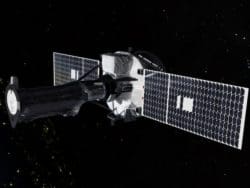
Image Credit: NASA/Goddard Space Flight Center
Launch Date: June 27, 2013
IRIS will make use of high-resolution observations and state-of-the-art computer models to unravel how matter, light, and energy move through the dense region of solar material at the bottom of the sun’s atmosphere. Understanding the interface between the sun’s surface and its atmosphere, the corona, is crucial to understanding what drives heat and energy into the corona, as well as what powers solar flares and coronal mass ejections. Improvements in technology ensure that this region can now be studied, when in the past it has been impossible to trace how light and material move through the dense area.
Orbit: IRIS will travel in a polar, sun-synchronous orbit at an altitude of over 400 miles above Earth. This means it will travel around Earth, crossing nearly directly over the poles, in such a way that it crosses the equator at the same local time each day. The orbit allows for eight months of continuous observations per year and maximizes eclipse-free viewing of the sun.
Mission Homepage »
MMS–Magnetospheric MultiScale
Launch Date: March 12, 2015
The Magnetospheric Multiscale (MMS) mission comprises four identically-instrumented spacecraft that will use Earth’s magnetosphere as a laboratory to study the microphysics of a fundamental plasma process known as magnetic reconnection. This occurs in all astrophysical plasma systems and catalyzes numerous space weather events from the aurora to explosions on the sun such as flares and coronal mass ejections (CMEs). Magnetic reconnection can only be studied in situ, however, in our solar system and is most accessible in Earth’s magnetosphere. Together the four spacecraft will be able to map the three-dimensional nature of these processes as well as monitor how they change over time.
Orbit: The four MMS spacecraft will be placed in an elliptical orbit around Earth that crosses through known magnetic reconnection sites throughout the magnetosphere. The first phase of the mission will focus on reconnection sites on the sun-side of Earth, and the second phase will focus on reconnection in Earth’s night-side magnetotail.
Learn more about MMS »
Mission Homepage »
Parker Solar Probe
Launch: August 12, 2018
Parker Solar Probe will be an extraordinary and historic mission, exploring what is arguably the last region of the solar system to be visited by a spacecraft: the sun’s atmosphere, the outer corona. Eventually approaching almost as close as 3.7 million miles above the sun’s surface, Parker Solar Probe will repeatedly sample the near-sun environment, revolutionizing our knowledge and understanding of coronal heating and of the origin and evolution of the solar wind. Moreover, by making direct, in-situ measurements of the region where some of the most hazardous solar energetic particles are energized, Solar Probe Plus will make a fundamental contribution to our ability to characterize and forecast the radiation environment in which future space explorers will work and live. The spacecraft has a large sun shield that will be built to withstand temperatures of 2,500° F, so that the instruments that lie in the shadow of the sun shield can remain at room temperature.
Orbit: Parker Solar Probe will be placed into an elliptical orbit around the sun. The size of the orbit will be decreased over nearly seven years using seven Venus flybys. Parker Solar Probe will orbit the sun 24 times, gradually “walking in” toward the sun with each pass. The closest points of each orbit come well within the path of Mercury— the closest planet to the sun. On the final three orbits, Parker Solar Probe will fly to within 3.7 million miles of the sun’s surface. That is about seven times closer than the current record-holder, the Helios spacecraft.
Learn more about Parker »
Mission Homepage »
RHESSI — Reuven Ramaty High Energy Solar Spectroscope Imager
Launch Date: February 05, 2002
RHESSI combines high-resolution imaging in hard X-rays and gamma rays with high-resolution spectroscopy to explore the basic physics of particle acceleration and energy release in solar flares. Such information improves our understanding of the fundamental processes that are involved in generating solar flares and coronal mass ejections. These super-energetic solar eruptive events are the most extreme drivers of space weather and present significant dangers in space and on Earth.
Orbit: Medium inclination orbit around Earth at an altitude of nearly 400 miles.
Learn more about RHESSI »
Mission Homepage »
SDO — Solar Dynamics Observatory
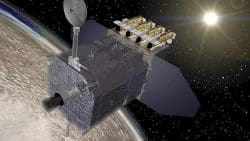
Image credit: NASA
Launch: February 11, 2010
SDO is the most advanced spacecraft ever designed to study the whole sun and its dynamic behavior deep inside the solar atmosphere at an unprecedented spatial and temporal resolution. The mission seeks to understand the sun as a star and its influence on Earth and near-Earth space by observing the solar atmosphere in many wavelengths simultaneously and on small scales of space and time. The mission is the cornerstone of a NASA science program called Living With a Star (LWS), which develops the scientific understanding necessary to address those aspects of the sun and solar system that directly affect life and society. SDO studies what creates solar activity causing various space weather effects. To do so, SDO is equipped to measure the sun’s interior, its magnetic field and the hot plasma of the solar corona.
Orbit: Geosynchronous orbit at an altitude of 22,000 miles
Learn more about SDO »
Mission Homepage »
SOHO — Solar and Heliospheric Observatory
Launch Date: December 02, 1995
A joint ESA/NASA mission, SOHO studies the sun, from deep inside its core to the outer corona and solar wind. A workhorse of the NASA Heliophysics System Observatory, SOHO has been capturing images of the dynamic flares and coronal mass ejections on the sun sine 1996. The mission has provided an unprecedented breadth and depth of information about the sun, with a unique combination of instruments that study its interior through the hot and dynamic atmosphere to the solar wind and its interaction with the interstellar medium. Its coronagraphs – images that observe the sun’s atmosphere by blocking out the bright sun in the middle – remain a key component for forecasting the speed, direction and strength of coronal mass ejections as they erupt from the sun. In addition to watching the sun, SOHO has become the most prolific discoverer of comets in astronomical history: as of 2012, over 2000 comets have been found by SOHO.
Orbit: SOHO orbits around the sun in step with Earth, by slowly orbiting around the first Lagrangian point (L1), approximately 950 thousand miles away from Earth (about four times the distance of the Moon), in the direction of the sun. This offers a continuous view of the sun.
Learn more about SOHO »
Mission Homepage »
Solar Orbiter
Launch: February 2020
Solar Orbiter is a joint ESA/NASA collaboration that will address a central question of heliophysics: How does the sun create and control the heliosphere? To answer this question, Solar Orbiter will make in-situ measurements of the solar wind plasma, fields, waves, and energetic particles by traveling closer to the sun than the previous record-holders, Helios 1 and 2 – traveling nearly three-quarters of the way to the sun, a journey of approximately 67 million miles. At that distance, Solar Orbiter will be able to observe solar processes that are still relatively pristine and have not had their properties modified by subsequent transport and propagation processes.
Orbit: Solar Orbiter will be placed into an elliptical orbit around the sun coming as close to 26 million miles away from the star every five months — even closer than Mercury. It will take three years to reach this orbit. When travelling at its fastest, Solar Orbiter will remain positioned over approximately the same region of the solar atmosphere as the sun rotates on its axis, allowing unprecedented observations. The inclined orbit will allow Solar Orbiter to better image the regions around the sun’s poles than ever before.
Learn more about Solar Orbiter »
Mission Homepage »
STEREO — Solar Terrestrial Relations Observatory
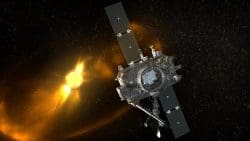
Image Credit: NASA
Launch Date: October 25, 2006
The STEREO mission employs two nearly identical space-based observatories –to provide the first-ever stereoscopic measurements to study the sun. With this new pair of viewpoints, scientists are able to see the structure and evolution of solar storms as they blast from the sun and travel out through space. STEREO’s instruments provide a unique combination of observations to help understand the causes and mechanisms of coronal mass ejection (CME) and to characterize how they propagate through the solar system. STEREO also helps determine what powers the acceleration of energetic particles from the sun and provides information on the structure of the solar wind.
Orbit: Both STEREO spacecraft orbit the sun, in orbits only slightly different than that of Earth. STEREO-A’s orbit is slightly smaller than Earth’s, causing it to move slightly faster. STEREO-B’s orbit is slightly larger, causing it to move slightly slower. Over time the spacecraft have separated, allowing each to have a different view of the sun. They are currently separated by a little over 180 degrees. Along with SDO, they are able to provide 360-degree coverage of the sun. For the first time we are able to see the whole sun at one time.
Learn more about STEREO »
Mission Homepage »
THEMIS — Time History of Events and Macroscale Interactions during Substorms
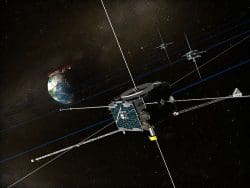
Image Credit: NASA
Launch Date: February 17, 2007
THEMIS answers longstanding fundamental questions concerning a type of space weather called a substorm that can abruptly and explosively release solar wind energy stored within Earth’s magnetotail. Substorms cause auroras at high latitudes, and THEMIS seeks to understand this process. Originally five spacecraft, THEMIS now consists of three, as two were repurposed to study the moon in the ARTEMIS mission. The mission also relies on a dedicated array of ground observatories located in Canada and the northern United States.
Orbit: The THEMIS spacecraft are now in similar highly elliptical orbits around Earth. Apogees are about 1/5 the distance to the Moon. Over the years, the orbits have been oriented along different axes to carry them through all parts of the magnetotail.
Mission Homepage »
TIMED — Thermosphere, Ionosphere, Mesosphere Energetics and Dynamics
Launch Date: December 07, 2001
TIMED explores Earth’s mesosphere and lower thermosphere (40-50 miles up), the least explored and understood region of our atmosphere. Solar events, as well as temperature changes in the stratosphere can perturb this region, but the overall structure of and responses to these effects are not understood. Advances in remote sensing technology employed by TIMED enable us to explore this region on a global basis from space.
Orbit: Polar-orbiting at about 380 miles in altitude.
Mission Homepage »
TWINS A & B — Two Wide-Angle Imaging Neutral-Atom Spectrometers
Launch Date: March 13, 2008
The TWINS instruments provide stereo imaging of Earth’s magnetosphere — the region surrounding the planet, controlled by Earth’s magnetic field and containing the Van Allen radiation belts and other energetic charged particles. TWINS enables three-dimensional global visualization of this region, which will lead to greatly enhanced understanding of the connections between different areas of the magnetosphere and their relation to the solar wind.
Orbit: Each spacecraft is in a highly elliptical orbit called a Molniya orbit, during which the spacecraft spends most of its time at the furthest point from Earth far out in the magnetosphere. The two orbits lie in perpendicular planes.
Mission Homepage »
Wind
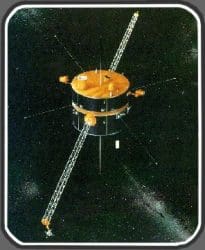
Image Credit: NASA GSFC
Launch Date: November 01, 1994
Wind’s mission is to measure crucial properties of the solar wind before it encounters Earth’s magnetic field and alters Earth’s space environment directly. These measurements are essential if we are to understand how the magnetosphere responds to changes in the solar wind driven by the sun. Wind also measures particles and radio emissions from the sun to help decipher the processes – present throughout the universe – that are responsible for accelerating particles to speeds and energies high enough to generate cosmic rays.
Orbit: Wind orbits the first sun-Earth Lagrange point (a stable point of gravitational balance between the sun and Earth) some 950,000 miles away from Earth, in a kidney-shaped orbit known as a Lissajous orbit. This puts Wind in position to constantly monitor the solar wind without being blocked by Earth.
Mission Homepage »
Van Allen Probes
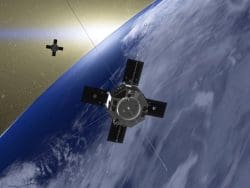
Image Credit: NASA GSFC
Launch Date: August 30, 2012
The Van Allen Probes (formally RBSP– Radiation Belt Storm Probes) consists of twin spacecraft that will study the extreme and dynamic regions of space known as the Van Allen Radiation Belts that surround Earth. The radiation belts intensify or weaken over time as part of the much larger space weather system driven by the energy and material that erupt off the sun’s surface and fill the entire solar system.
Orbit: The two RBSP spacecraft will have nearly identical elliptical orbits around Earth. The orbits cover the entire radiation belt region and the two spacecraft will lap each other several times over the course of the mission.
Learn more about the Van Allen Probes »
Mission Homepage »
Voyager 1 and 2
Launch Date: September 05, 1977 (Voyager 1) and August 20, 1977 (Voyager 2)
The twin spacecraft Voyager1 and Voyager 2 were launched by NASA two weeks apart in the summer of 1977. As originally designed, the Voyagers were to conduct close up studies of Jupiter and Saturn. They discovered among other things, volcanoes on Jupiter’s moon Io, and spokes in Saturn’s rings. As the mission went on, and with the successful achievement of all its objectives, Voyager 2 passed by Uranus and Neptune and discovered additional moons and the planets’ magnetospheres. As the spacecraft flew across the solar system, remote-control reprogramming was used to grow their capabilities. In 1990 they took the “pale blue dot” images that put in context the dimensions of the solar system with the universe. On board, they carry the ‘Golden Record’ of 1970’s images and music from across all cultures. Both spacecraft now continue with the Voyager Interstellar Mission, providing scientists with valuable observations of the solar system’s edge — and soon interstellar space as well — as they move closer to the heliosphere’s boundary. At 120 times the distance from the sun as Earth, Voyager 1 is now the farthest human-made object from the sun.
Orbit: Solar escape trajectories heading towards the nose of the heliosphere where it is most compressed by the interstellar medium surrounding it.
Mission Homepage »
Past Missions
AIM – Aeronomy of Ice in the Mesosphere
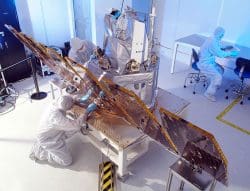
Credit: NASA
Launch: April 25, 2007 • End: August 19, 2024
Mission: Fifty miles above the ground, Earth’s highest clouds form an icy membrane at the edge of the atmosphere. AIM’s mission is to study these mysterious Polar Mesospheric Clouds. The primary goal of the AIM mission is to determine why these clouds form and why they vary. Another major goal is to understand the influence of Earth’s changing climate on the frequency of formation of the clouds.
Orbit: AIM orbits around Earth in a near-circular, sun-synchronous orbit, which is a low-altitude orbit that passes over any given point on Earth at approximately the same local time. At an altitude of some orbit altitude of 370 miles, AIM can look down on the polar mesospheric clouds from above.


